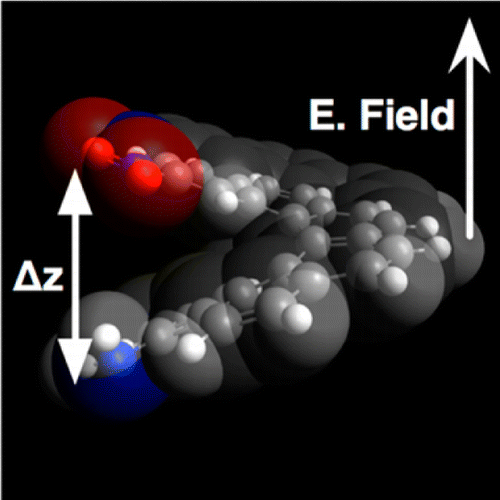Single-Molecule Piezoelectric Deformation
Xinfeng Quan, Christopher W Marvin, Leah Seebald, and Geoffrey R Hutchison. “Single-Molecule Piezoelectric Deformation” J. Phys. Chem. C. 2013, 117 (33), pp 16783–16790. Online. Supporting information is available at QuanSI.
 Conventional piezoelectric materials change shape in response to an applied external electric field, frequently deforming at grain boundaries in addition to intrinsic unit cell changes. We detail a computational investigation, using density functional theory (DFT) calculations of single-molecule piezoelectrics. Rather than deforming along covalent bond lengths or angles, these molecular springs, derivatives of [6]helicene and phenanthrene, change conformation in response to the applied field, up to 15% of the molecular length. A substituted [6]helicene has a predicted piezo coefficient of 45.8 pm/V, and one of the phenanthrenes yields a piezoelectric coefficient of up to 54.3 pm/V, which is significantly higher than polymers such as polyvinylidine difluoride (PVDF) and comparable to conventional inorganic materials such as zinc oxide (ZnO). We discuss structural properties that are found to yield large piezo response and hypothetical target molecules with up to 64% length change and a predicted piezoelectric coefficient of 205 pm/V. Based on these findings, we believe a new class of highly-responsive piezoelectric materials may be created from the “bottom up,” yielding immense electromechanical response.
Conventional piezoelectric materials change shape in response to an applied external electric field, frequently deforming at grain boundaries in addition to intrinsic unit cell changes. We detail a computational investigation, using density functional theory (DFT) calculations of single-molecule piezoelectrics. Rather than deforming along covalent bond lengths or angles, these molecular springs, derivatives of [6]helicene and phenanthrene, change conformation in response to the applied field, up to 15% of the molecular length. A substituted [6]helicene has a predicted piezo coefficient of 45.8 pm/V, and one of the phenanthrenes yields a piezoelectric coefficient of up to 54.3 pm/V, which is significantly higher than polymers such as polyvinylidine difluoride (PVDF) and comparable to conventional inorganic materials such as zinc oxide (ZnO). We discuss structural properties that are found to yield large piezo response and hypothetical target molecules with up to 64% length change and a predicted piezoelectric coefficient of 205 pm/V. Based on these findings, we believe a new class of highly-responsive piezoelectric materials may be created from the “bottom up,” yielding immense electromechanical response.